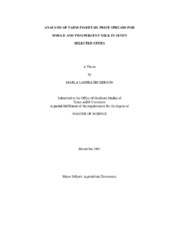| dc.description.abstract | The objectives of this study were threefold: (1) to determine a suitable model for defining the farm-retail price spread for two percent and whole milk in seven cities (Atlanta, Boston, Chicago, Dallas, Hartford, Seattle, St. Louis); (2) to discover the determinants that contribute significantly to the price spreads of two percent and whole milk in seven selected cities, and (3) to calculate the elasticity of price transmission for whole and two percent milk in the seven cities. The work of Wohlgenant and Mullen in -Modeling the Farm-Retail Price Spread for Beef" was followed in order to determine a suitable model. The two specifications considered were the markup pricing model and the relative price spread model. Factors considered to affect the farm-to-retail price spread of whole and two percent milk were the retail price for whole and two percent milk, marketing costs such as fuel and labor costs, milk production, seasonality, and structural change.
Monthly data were collected over a 106 month period from January 1994 through October 2002 for the selected cities in this investigation. Principal findings from the analysis are the following. The markup pricing model was determined to be the better model for both products throughout the seven cities through the examination of the Schwarz and Akaike criteria of model selection. The driving forces of the farm-to-retail price spread for whole and two percent milk in most cites were retail price and seasonality. In addition, the price spreads in the Northeast were significantly lower before and during the implementation of the Northeast Dairy Compact compared to the period corresponding to the termination of the program. The price spreads of both whole and two percent milk were highest in the third quarter and lowest in the fourth quarter.
Elasticities of price transmission, measures of the sensitivity of retail prices to changes in farm prices, were higher in all regions for two percent milk compared to whole milk. The range of the elasticities of transmission for whole milk was from 0.37 (Hartford) to 2.54 (Dallas) and from 0.39 (Hartford) to 3.66 (Dallas) for two percent milk. | en |


